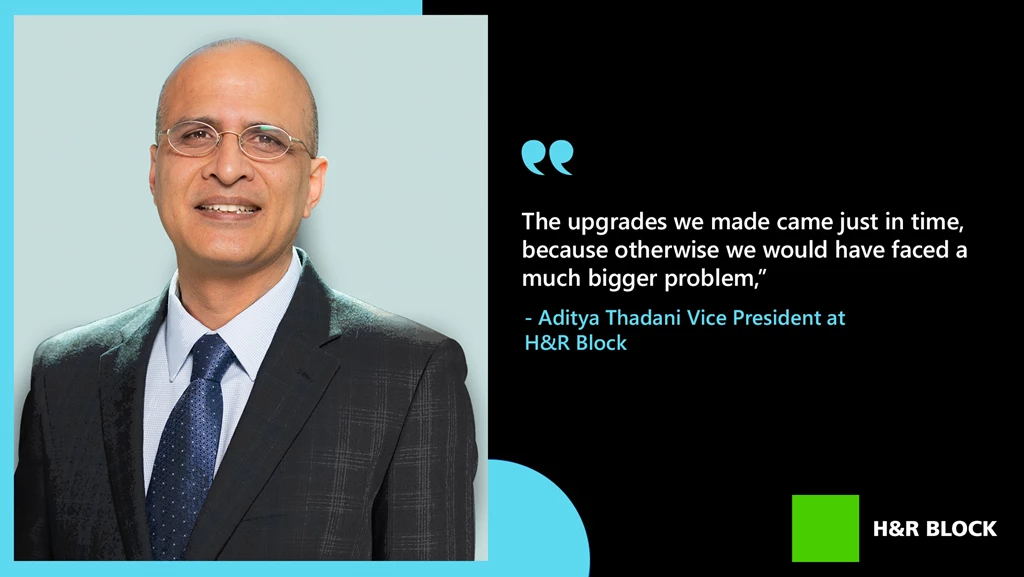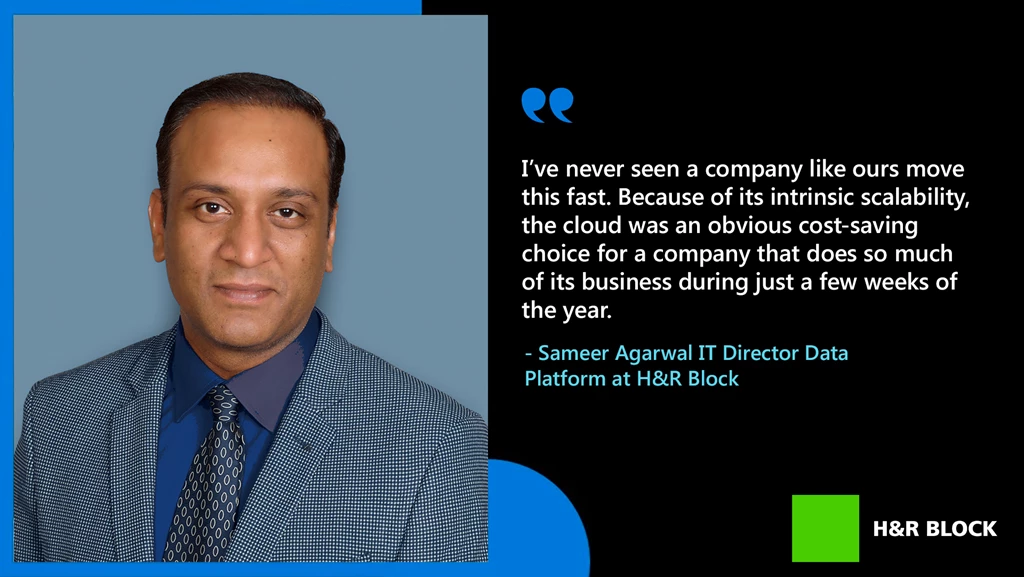Azure SQL Database, Databases, Management and Governance, Thought leadership
H&R Block’s blockbuster data strategy
Posted on
6 min read
If you think your company isn’t making the most of its data, you’re probably right.
Just ask H&R Block. In 2019, before most people began sheltering in place due to COVID, the company rolled out a new data platform that would allow it to digitally serve the 13 million people who usually get their taxes done via tax prep experts at one of the company’s 10,000-plus retail offices.
“The upgrades we made came just in time because otherwise, we would have faced a much bigger problem,” says Aditya Thadani, the company’s vice president in charge of digital transformation and enterprise architecture.

H&R Block’s new data strategy, based on Microsoft’s Intelligent Data Platform, has been an essential ingredient in possibly the most sweeping strategic expansion in the company’s 67-year history. Rather than just focusing on tax-preparation services—a large percentage of the company’s revenues are booked in the two weeks before Tax Day—the company has become a player in the much larger market for small business services and has introduced a mobile banking app for consumers.
As a result, H&R Block is now a Wall Street darling. As of January 2023, the company’s share price had nearly tripled since the new data strategy was put in place.
While the timing may have been fortunate, the story nonetheless shows how a well-executed data modernization strategy can have a massive impact on everything from the speed of innovation to customer experience to bottom-line results.
From obstacle to enabler
The seeds of this resurgence were planted in 2017, when new CEO Jeff Jones began thinking about ways to leverage H&R Block’s reputation and retail presence to establish a broader, deeper relationship with clients throughout the year. Why stop at tax help, when small business owners who were short on time and sometimes financial expertise also needed help with payroll, invoicing, and strategy? Why not empower its 8 million “under-banked” clients—typically less-affluent people who don’t have, or don’t take full advantage of, a bank account—to participate more fully in the digital economy?
“We wanted to serve the client the way they want, where they want, but could we really?”
But there was a problem. The company’s previous approach to data was not up to the job. In fact, the walk-in business, which serves 13 million clients, and the online software business, which serves an additional 7 million, felt like two different companies. While the company has offered an online service since 2004, if a “DIY” client who did their taxes online walked into a retail location for some extra help, the tax pros there would have no record that they existed. To get help, they would have had to begin a new tax return from scratch, starting with their name and address. Similarly, walk-in clients couldn’t easily update or continue working on their tax return online once they got home.
“We tried to serve the client the way they want, where they want, but could we really?” says Thadani. “We had two operating units running on two different technology stacks that didn’t talk to each other. The information was completely siloed, introducing friction as clients switched from one channel to another.”
In early 2018, Jones approved investments to make IT a catalyst, rather than an obstacle, to fully realizing this vision.
A new data platform strategy
Step one was obvious, but formidable: to transform the company’s underlying architecture from on-premises technology running in the company’s Kansas City data center to the cloud. Over an eight-month period, a team led by Sameer Agarwal, IT director of data platforms, migrated a million lines of code running on legacy AS400 and Netezza appliances to Microsoft SQL Server, and consolidated five racks of data appliances into a single rack of servers to handle applications that still needed to run on-premises. Today, 75 percent of the company’s workload is managed on Microsoft Azure, and Agarwal expects that to rise to 90 percent by mid-2023.
“I’ve never seen a company like ours move this fast,” says Agarwal, who joined H&R Block in 2007 after years as a consultant with Tata Consultancy Systems.

Because of its intrinsic scalability, the cloud was an obvious cost-saving choice for a company that does so much of its business during just a few weeks of the year. But management’s focus was less on short-term cost savings and more on unleashing innovation that could provide year-round value to clients. To that end, Thadani’s team insisted on creating a unified architecture that brought all of that siloed data and business intelligence into a single platform.
“Management’s focus was less on short-term cost savings and more on unleashing innovation that could provide year-round value to clients.”
The team made fast progress, and by 2019 the benefits were becoming evident internally. With an architecture built around cloud-native technology, business unit leaders found they could use data from across multiple products to quickly convert Jones’s high-level vision into crisp business insights and execution. In the past, it could take several months just to get IT to incorporate a new type of data into reports—say, to study the impact a new digital service was having on the walk-in business. Now they can deliver it in days, says Thadani.
Building “the Block experience”
The strongest evidence of the changes began showing up in the products themselves. In 2018, the company rolled out a new price preview feature that let filers know up front how much their return would cost, rather than have the price change based on the number of tax forms required. Later that year, it introduced a number of hybrid options. One service lets clients have a tax pro do their return, without their having to even go to the office; another one lets DIY filers have a tax expert check their work and then sign and file the return on their behalf; a third lets clients leave their documents with a preparer at an H&R Block office and go home.
“In the past, it could take several months just to get IT to incorporate a new type of data into reports. Now we can deliver it in days.”
Since then, the company’s product developers have continued to let clients use whatever mix of virtual and human help serves their needs—a vision that was tailor-made to serve clients after the pandemic hit. For example, many clients that had grown used to filing their taxes online suddenly had questions about how to account for COVID stimulus checks. Thanks to the new architecture, the company was able to quickly create an online assistance add-on service that lets clients ask such questions for an extra $20. And in January 2022, it introduced a mobile banking app just six months after development began. Thadani thinks it would have taken considerably longer if the old architecture were still in place.
The benefits go far beyond speed. In the old approach, Thadani’s team lacked the in-house data science skills or tools to make use of machine learning and other emerging technologies. Now, by taking advantage of the capabilities in Azure, the company has streamlined the data-gathering process so that the company’s more than 90,000 tax pros spend less time on routine work like determining which of the tax documents will be required to complete a return, and more time advising clients.
Originally, this was viewed as a productivity-enhancing process improvement. But it is also making the company’s clients more satisfied. The use of online capabilities by traditional walk-in clients tripled in the 2022 tax year. In early October 2022, the company announced a business formation service to help entrepreneurs choose the right corporate structure, whether on their own or with the help of an H&R adviser.
The great unlearning
Thadani believes an increased appreciation for the power of data has set off a cultural shift inside the IT organization that will continue to pay dividends in the coming years. The move to the cloud and away from high-maintenance legacy systems means engineers spend less time worrying about technical details and more on how to use technology to solve business problems. “It makes their jobs more fun and allows them an opportunity to have a bigger impact on our business,” he says.
Looking back, Thadani says the biggest challenge wasn’t getting people to learn new tricks but to unlearn old ones.
“When you have a company with a long history and people with long tenures, all that experience sometimes gets in the way,” he says. “We have people who are very good at their jobs and are used to doing things the same way for years. Now we’re offering them a new way to do it. That’s not always easy.”
While it may not be easy, it certainly is becoming more compelling, as the company’s tax pros come to understand how much more expansive their business relationships with clients can be.
“We are having deeper, richer conversations with our clients about their overall financial health, as opposed to simply saying, ‘Here are your tax returns,'” says Thadani. “And that’s only possible because we now have a full view of every client.”
Learn more about how H&R Block modernized its data platform with Azure
If you’d like to hear more on this Azure customer story, watch the H&R Block Learn from the Leaders: Optimize your Data Estate webinar